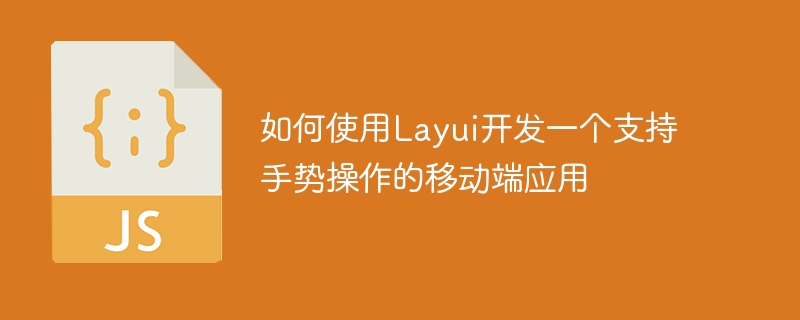

How to use Layui to develop a mobile application that supports gesture operations
The popularity of mobile devices has allowed people to use more mobile phones and tablets to access and use the Internet. Therefore, it is very important to develop a mobile application that supports gesture operations. This article will introduce how to use Layui to accomplish this task and provide specific code examples.
Layui is a front-end framework based on HTML, CSS, and JavaScript. It is simple and easy to use, and is suitable for rapid development of mobile applications. Before starting, we need to make sure that the relevant files of Layui have been introduced. Then, we can follow the steps below to develop a mobile application that supports gesture operations.
Step 1: Create HTML structure
We first need to create a basic HTML structure, including a container to display the effects of gesture operations. An example is as follows:
<!DOCTYPE html>
<html>
<head>
<meta charset="utf-8">
<title>支持手势操作的移动端应用</title>
<link rel="stylesheet" href="path/to/layui/css/layui.css">
<script src="path/to/layui/layui.js"></script>
</head>
<body>
<div id="gesture-container"></div>
</body>
</html>Step 2: Initialize the Layui module
In the HTML structure, we have introduced Layui’s CSS and JavaScript files, and then we need to initialize the Layui module. An example is as follows:
layui.use(['layer'], function(){
var layer = layui.layer;
// 初始化代码写在这里
});Step 3: Define the gesture operation function
In the callback function that initializes the Layui module, we need to define a function that supports gesture operations. Layui provides a gesture module to handle gesture operations. We can use this module to achieve the effects of gesture operations. An example is as follows:
layui.use(['layer', 'gesture'], function(){
var layer = layui.layer;
var gesture = layui.gesture;
// 获取手势容器
var container = document.getElementById('gesture-container');
// 手势操作函数
gesture.on(container, 'tap', function(){
layer.msg('您点击了屏幕');
});
gesture.on(container, 'longtap', function(){
layer.msg('您长按了屏幕');
});
gesture.on(container, 'swipe', function(){
layer.msg('您滑动了屏幕');
});
gesture.on(container, 'pinch', function(){
layer.msg('您捏合了屏幕');
});
gesture.on(container, 'rotate', function(){
layer.msg('您旋转了屏幕');
});
});In the sample code, we define functions for different gesture operations through the gesture.on() method. For example, when the user clicks on the screen, a prompt box pops up to display the text "You clicked on the screen." You can define your own gesture operation functions according to your needs.
Step 4: Improve the style
Finally, we also need to improve the application style. Gesture containers can be styled through CSS. An example is as follows:
#gesture-container {
width: 100%;
height: 100%;
background-color: #f2f2f2;
text-align: center;
}In the example code, we set the gesture container to full screen and set some basic styles.
Through the above steps, we have completed the process of using Layui to develop a mobile application that supports gesture operations. You can run the code and test the effect of the app through gesture operations such as click, long press, swipe, pinch, and rotation. Hope this article helps you!
The above is the detailed content of How to use Layui to develop a mobile application that supports gesture operations. For more information, please follow other related articles on the PHP Chinese website!